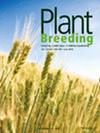鉴定与春燕麦(Avena sativa L.)抗禾谷镰刀菌相关的单倍型
IF 1.8
4区 农林科学
Q2 AGRONOMY
引用次数: 0
摘要
头孢镰刀菌疫病(FHB)是挪威燕麦的主要病害,由禾谷镰刀菌(Fusarium graminearum)引起。它导致产量损失、种子质量下降、发芽能力降低和脱氧雪腐镰刀菌烯醇(DON)积累。FHB 抗性是定量的,大多数基因的作用很小。在育种计划中使用具有验证效应的标记可进一步提高抗性育种水平。本研究旨在通过全基因组关联研究(GWAS),利用一个由 541 个品系组成的大型多样化群体,鉴定与 FHB 抗性相关的数量性状位点(QTL),并在独立育种材料中验证其效果。这些材料已在三年中的六个环境和两个地点的卵接种和雾灌溉病害试验中进行了测试。测试的性状是发芽能力和 DON 积累。在 12 个不同的连锁群中共检测到 15 个重要的 QTL 区域。为每个区域构建了单倍型,并计算了等位基因在每个环境中的效应,从而确定了最可能的抗性和易感性等位基因。五个 QTL 区域经过验证,在 GWAS 群体和育种材料中显示出一致的效应。这些区域的抗性等位基因从 0 到 5 的堆叠显示,DON 值显著下降,发芽能力增强。对一组历史和现代北欧品种的单倍型信息进行了分析,分析结果可用于选择未来杂交的亲本。本研究验证的单倍型可用于标记辅助选择(MAS)或改进育种计划中的基因组预测模型。本文章由计算机程序翻译,如有差异,请以英文原文为准。
Identification of haplotypes associated with resistance to Fusarium graminearum in spring oat (Avena sativa L.)
Fusarium head blight (FHB) is the predominant disease in oat in Norway caused by the fungus Fusarium graminearum. It causes yield loss, reduced seed quality, reduced germination ability and accumulation of deoxynivalenol (DON). The FHB resistance is quantitative, and most genes have small effect. Markers with verified effect in the breeding program could further enhance the resistance breeding. This study aims to use a large and diverse population of 541 lines to identify quantitative trait loci (QTL) associated to FHB resistance in a genome-wide association study (GWAS) and verify their effect in independent breeding material. The material has been tested in six environments over three years and two locations in spawn inoculated and mist irrigated disease trials. The traits tested were germination ability and DON accumulation. A total of 15 significant QTL-regions were detected across 12 different linkage groups. Haplotypes for each region was constructed and the effect of the alleles in each environment was calculated, which identified the most likely resistant and susceptible alleles. Five QTL-regions were validated showing consistent effect in the GWAS population and the breeding material. Stacking of the resistant alleles of these regions from zero to five showed significant decrease in DON values and increased germination ability. The haplotype information of a set of historical and modern Nordic varieties were analysed, and the results could be used to select parents for future crossings. The validated haplotypes from this study can be used either to do marker assisted selection (MAS) or improve genomic prediction models in breeding programs.
求助全文
通过发布文献求助,成功后即可免费获取论文全文。
去求助
来源期刊

Plant Breeding
农林科学-农艺学
CiteScore
4.40
自引率
5.00%
发文量
74
审稿时长
3.0 months
期刊介绍:
PLANT BREEDING publishes full-length original manuscripts and review articles on all aspects of plant improvement, breeding methodologies, and genetics to include qualitative and quantitative inheritance and genomics of major crop species. PLANT BREEDING provides readers with cutting-edge information on use of molecular techniques and genomics as they relate to improving gain from selection. Since its subject matter embraces all aspects of crop improvement, its content is sought after by both industry and academia. Fields of interest: Genetics of cultivated plants as well as research in practical plant breeding.
 求助内容:
求助内容: 应助结果提醒方式:
应助结果提醒方式:


